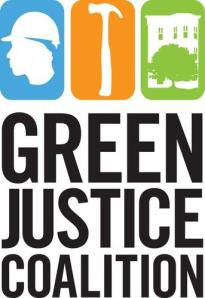Blog Archives
A new ally in the fight against gentrification

PODER mural, created in partnership with CiultureStrike. Photo credit: Galeria de la Raza
The fight against gentrification is never-ending; therefore, it takes a certain type of momentum to achieve groundbreaking changes. There are environmental justice (EJ) organizations working in various parts of the United States that have been able to achieve this momentum. Genea Foster, MCP’ 16 uses case studies of Boston, Oakland, Portland, Austin, San Francisco and Brooklyn to generate a deeper understanding of the success and impact of the anti-gentrification campaigns of environmental justice organizations. She has determined how community-led initiatives are making a difference and why they are taken seriously by developers and gentrifiers in their respective cities. Through coalition-building, partnerships, community engagement and cooperative economics, EJ organizations have been able to make progress.
Genea highlights a number of ways that planners can learn from these case studies to prevent gentrification in the cities where they work. Download her thesis to learn more about these innovative EJ organizations.
Can grass-roots innovation be scaled-up through the design and maintenance of social and policy networks?
 The states are the “laboratories of democracy. ” They are often the source of new policy ideas, including new strategies for encouraging investment in renewable energy. Some of these ideas spread; others don’t. The process of diffusion is inherently a social process; implementation is achieved via a network of actors. Ryan Cook’s thesis looks closely at the way in which Solarize, a community-based energy program has moved across the country.
The states are the “laboratories of democracy. ” They are often the source of new policy ideas, including new strategies for encouraging investment in renewable energy. Some of these ideas spread; others don’t. The process of diffusion is inherently a social process; implementation is achieved via a network of actors. Ryan Cook’s thesis looks closely at the way in which Solarize, a community-based energy program has moved across the country.
Ryan Cook (MCP ’14) examines the way policy actors adopt and adapt innovative ideas to their particular needs. Through a study of Solarize on both the west coast and the east coast, Ryan documents the way in which network structure can facilitate the spread of energy programs. He argues that policy innovations are rarely entirely original. Instead, they are often an amalgamation of ideas which have been implemented elsewhere. The pathways that new policy ideas follow lead to substantial differentiation. For example, the core elements of Solarize include competitive contractor selection, community-based outreach, public education, and limited sign-up campaigns. However, as Solarize moved around the country, there are some versions that involve multiple contractors as well as different technologies.
By analyzing the social networks underlying the process of policy adoption, Ryan has discovered that issue-specific relationships that cross multiple policy networks are important. He has also identified organizational creativity, programmatic flexibility, and a commitment to continuous learning (rather than just imitation) as important explanations for why and how policy innovations diffuse. Read more about the ways in which grass roots innovation can be scaled-up through the design and maintenance of social and policy networks. Ryan’s thesis complete thesis can be accessed here.
Bringing the Outsiders In: Social Movement Advocacy in the Planning Process
 In 2008, the Massachusetts Green Communities Act opened up new sources of funding to help the state reach its ambitious energy efficiency goals. The responsibility for allocating these funds was given to a group of diverse stakeholders, the Massachusetts Energy Efficiency Advisory Council. One stakeholder, Community Labor United (CLU), was intent on using the process to push its environmental justice mission aimed at generating high-paying jobs and community-level benefits.
In 2008, the Massachusetts Green Communities Act opened up new sources of funding to help the state reach its ambitious energy efficiency goals. The responsibility for allocating these funds was given to a group of diverse stakeholders, the Massachusetts Energy Efficiency Advisory Council. One stakeholder, Community Labor United (CLU), was intent on using the process to push its environmental justice mission aimed at generating high-paying jobs and community-level benefits.
Eric Mackres (MCP ’10) studied how CLU incorporated both organizational efforts and collaboration into its activities. In doing so, CLU blurred the line between traditional social movement strategies (from the outside) and participation (from the inside) in the planning process. CLU had to learn to find the middle ground both among its own constituency—which included labor groups, environmental advocates, and community organizers—and with utilities and other parties with an interest in energy efficiency funding.
While CLU made occasional missteps in shifting between collaboration and organizing, in the end they were effective in securing funding for community-based pilot programs that would further their environmental justice goals. Eric credits much of CLU’s success to its hybrid strategy that combined social movement theory and collaborative decision-making. He suggests that the two styles of planning can be combined more frequently with good results. Read more about CLU and how these two schools of thought can be combined in Eric’s thesis here.
Unlocking Energy Efficiency in Office Buildings
Energy consumption can vary widely among similar office buildings, and most could save 10-20% from low and no cost measures alone. Through her applied research with the Smart Energy Now® pilot program, Elena Alschuler (MCP ’12) analyzed stakeholder dynamics and tested solutions to encourage operational efficiency in office buildings.
Duke Energy’s Smart Energy Now® pilot in Charlotte NC is the first advanced metering and community engagement program to focus exclusively on operational efficiency in office buildings across an entire downtown. During the program design phase in 2011, Elena identified the ways in which building owners, facility staff, occupant organizations and office workers shape energy consumption. She recommended program activities to deliver information feedback, process assistance, and social
endorsement tailored to each stakeholder group.

In 2012, Elena conducted a preliminary evaluation and found that the pilot has been successful in many of its activities, gaining almost 100% owner participating and training over 500 Energy Champions. She also identified important lessons for implementing operational efficiency programs. For example, pledge-and-tracking frameworks establish a clear goal and process, but allow stakeholders to select the energy-saving activities that make sense for them. In addition, support from organizational leaders is essential for efficiency to become part of office worker culture and facility staff activities. Finally, local non-profit and professional organizations can help provide credibility, conduct outreach and deliver program activities.
Check out a recent report Elena wrote for the American Council for an Energy Efficient Economy (ACEEE), which builds on the work she did for her thesis as a DUSP student. Share your thoughts on this topic in the EPP Facebook Group.